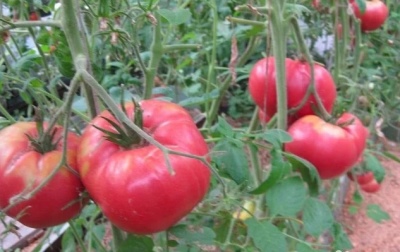
- Category: grade
- Appointment: universal
- Ripening period: early
- Ripening time, days: 85-100
- Growing conditions: for open ground, for closed ground
- Bush characteristic: powerful
- Ripe fruit color: red-crimson
- Fruit shape: flat-round
- Fruit weight, g: up to 800
- Pulp: sugar break
Domestic breeders are successfully developing tomato varieties that can combine excellent taste, large fruits, have a universal purpose in cooking, and also have high adaptive properties to various climatic conditions. All these properties are inherent in the Ural giant tomato. The increased content of lycopene in fruits makes it an indispensable vegetable on the table, since this microelement protects the body from the development of cancer.
Description of the variety
Plant of indeterminate type. The bushes are tall, liana-like, reaching a height of 1.5-2 m, so the culture needs a constant tie to the support. If this is not done, then the culture begins to creep along the ground, or the stems will break off, which will affect the development of the bushes, the timing of fruiting and the amount of harvest.
The plants themselves are very powerful. On thick stems, large leaves are dark green in color. A flower ovary is formed over 3-5 leaves. 5 tomatoes are formed on one cluster, which are so heavy that the stems need a mandatory garter.
The main qualities of the fruit
Tomatoes are really unimaginable sizes. On average, the weight of one fruit reaches 800 grams, and this is not the limit. The shape is rounded-flat, moderately ribbed, red-raspberry color. The pulp is juicy, multi-chambered, with a small amount of seeds. The skin is thin and delicate. Keeping quality is poor. Ripe fruits deteriorate quickly, so they need to be processed in a timely manner.
Taste characteristics
The Ural giant is distinguished by its "watermelon" pulp, which has a real "tomato" flavor. It is very juicy, meaty and sugary. The taste is delicious, very sweet, without sourness. These tomatoes make delicious salads. And also tomatoes are suitable for making sauces, juices and ketchups. The variety is rich in vitamins, macro- and microelements.
Ripening and fruiting
The plant is famous for its early maturity. Technical ripeness occurs 85-100 days after germination. Long-term fruiting. Harvesting begins in July, which lasts until September inclusive.
Yield
High-yielding variety. More than 10 kg of ripe fruits can be obtained from one bush.
The timing of planting seedlings and planting in the ground
Seeds for seedlings are sown in late March - early April. Before planting, the planting material is disinfected in a weak solution of potassium permanganate, and soaked for a day in a solution to stimulate development. When 3 full-fledged leaves appear on the seedlings, they begin to dive.
2 weeks before disembarking to a permanent place, the seedlings must be hardened. Leaving it in the fresh air at first for 10-15 minutes, increasing the time to 2 hours. You can start transplanting seedlings into the greenhouse in late April - early May. Outdoors - late May - early June. The main thing is to avoid the threat of return frosts at night. For better adaptation, the plants can be covered with agrofibre at first.
Before planting, the site is pre-prepared.It is necessary to dig up the soil, remove weeds and roots, and apply organic fertilizers. And it is also necessary to take care of the supports in advance, the bushes grow taller than human height during the season, and you need to tie up constantly.

Growing tomato seedlings is an extremely important process, because it largely depends on whether the gardener will be able to harvest at all. All aspects must be taken into account, from seedbed preparation to planting in the ground.
Landing scheme
Since tomatoes are very powerful, they need to develop normally and not thicken each other. To do this, you need to strictly observe the distance between the bushes 30 x 50 cm when planting. No more than 2 bushes are planted per 1 sq. m.

Growing and care
Due to the fact that the plant is tall, it is recommended to grow it in 1 stem. And also the Ural giant responds positively to the regularly applied top dressing.
Irrigation is carried out as the soil dries up. It is impossible to fill the soil, you also need to avoid getting moisture on the foliage and stems, which can lead to the development of a fungal infection. It is necessary to regularly loosen the soil and remove weeds.
Pinching is constantly carried out, since the growth is continuous. For good development, a crop requires a fertile soil mixture.




A plant needs different micronutrients at each stage of growth. All fertilizers can be divided into two groups: mineral and organic. Folk remedies are often used: iodine, yeast, bird droppings, eggshells.
It is important to observe the rate and period of feeding. This also applies to folk remedies and organic fertilizers.
Disease and pest resistance
Despite its significant advantages, the variety has a weak immunity to late blight and most of the fungal infectious diseases. For the prevention of diseases, plants are sprayed with special preparations before flowering.


Resistant to adverse weather conditions
The variety is able to grow both in conditions of prolonged drought and in regions with low temperatures.
Growing regions
The Ural giant can be cultivated in all regions of the country.

























































































